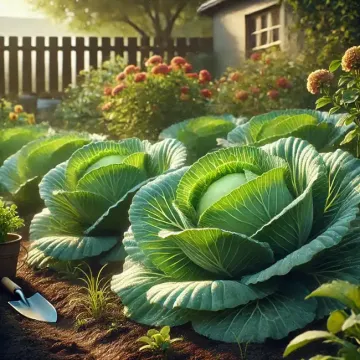Cabbage is a versatile, cool-season vegetable that has been a staple in home gardens for centuries. Known for its dense, leafy heads, cabbage is a member of the Brassica family, which also includes broccoli, kale, and cauliflower. With the right care, cabbage can thrive in a variety of climates and provide a bountiful harvest. This article explores the history of cabbage, its health benefits, culinary uses, and tips for growing cabbage in the home garden.
History of Cabbage
Cabbage has a long and storied history, originating in Europe as far back as 4,000 years ago. It was cultivated by the ancient Greeks and Romans, who valued it for both its medicinal properties and culinary uses. Cabbage spread throughout Europe and eventually made its way to the Americas with early settlers. Over time, it became a vital crop due to its ability to store well during winter months, making it a reliable food source during lean times.
Health Benefits of Cabbage
Cabbage is a nutrient-dense vegetable, offering a range of health benefits. It is an excellent source of vitamin C, vitamin K, and fiber. The vegetable is also rich in antioxidants, particularly anthocyanins (in red cabbage), which help protect the body from oxidative stress and inflammation. Additionally, cabbage contains sulfur compounds that have been linked to cancer prevention. Eating cabbage regularly can contribute to overall heart health, digestion, and immune system support.
Culinary Uses of Cabbage
Cabbage is highly versatile in the kitchen and can be used in a wide array of dishes. Some of the most popular preparations include:
- Salads and Slaws: Shredded raw cabbage is a key ingredient in coleslaw and various salads. Its crunchy texture and mild flavor pair well with a range of dressings.
- Fermented Foods: Cabbage is famously used in sauerkraut and kimchi, two fermented dishes that offer probiotic benefits for gut health.
- Soups and Stews: Cabbage adds bulk and flavor to soups and stews, making it a common ingredient in hearty dishes like borscht and cabbage soup.
- Stuffed Cabbage: Cabbage leaves can be used to wrap fillings such as rice, meat, or vegetables, then baked or steamed for a delicious and satisfying meal.
Growing Cabbage in the Home Garden
1. Choosing Varieties There are several types of cabbage to consider for your home garden:
- Green Cabbage: The most common variety with smooth, light green leaves.
- Red Cabbage: Known for its striking purple-red color and slightly peppery flavor.
- Savoy Cabbage: Distinguished by its crinkled, deep green leaves and mild, sweet flavor.
- Napa Cabbage: A Chinese variety with elongated heads and tender, pale green leaves.
When selecting a variety, consider your climate, growing season, and personal taste preferences.
2. Planting Cabbage is a cool-season crop that can be grown in both spring and fall. For a spring harvest, start seeds indoors 6-8 weeks before the last expected frost. Once seedlings have developed 3-4 leaves and the danger of frost has passed, transplant them into the garden. For a fall crop, sow seeds directly into the garden in midsummer.
Cabbage prefers full sun and well-drained, fertile soil with a pH between 6.0 and 6.8. Space plants 12-24 inches apart, depending on the variety, to allow ample room for the heads to develop.
3. Watering and Fertilizing Cabbage needs consistent moisture to thrive, so be sure to water regularly, providing 1 to 1.5 inches of water per week. Mulching around the plants can help retain moisture and keep the soil cool.
Fertilize cabbage with a balanced fertilizer, such as a 10-10-10 formula, when planting and again when the heads start to form. Adding compost or well-rotted manure to the soil before planting can also improve soil fertility.
4. Pests and Diseases Cabbage is susceptible to several pests and diseases, including:
- Cabbage Worms: These green caterpillars can decimate cabbage leaves. Inspect plants regularly and remove any worms by hand or use organic pest control methods such as Bacillus thuringiensis (Bt).
- Aphids: Small, soft-bodied insects that feed on plant sap. Spray affected plants with a strong jet of water or use insecticidal soap.
- Cabbage Root Maggots: These pests attack the roots, causing plants to wilt and die. Floating row covers can help prevent adult flies from laying eggs near the plants.
- Black Rot: A bacterial disease that causes yellowing and wilting of leaves. Prevent black rot by rotating crops and avoiding overhead watering.
5. Harvesting Cabbage heads are ready to harvest when they are firm to the touch and reach a desirable size, typically 60 to 100 days after planting, depending on the variety. Use a sharp knife to cut the heads from the base, leaving a few outer leaves on the plant. If timed correctly, some varieties may produce smaller secondary heads after the main head is harvested.
6. Storing Freshly harvested cabbage can be stored in the refrigerator for several weeks. For long-term storage, cabbage can be kept in a root cellar or cool, dark place with high humidity. It can also be preserved through fermentation (such as making sauerkraut) or freezing.
Conclusion
Growing cabbage in the home garden can be a rewarding experience, providing a nutritious and versatile crop that can be used in a wide range of dishes. With proper care, pest management, and timely harvesting, you can enjoy fresh cabbage throughout the growing season. Whether you're making a crisp coleslaw, hearty soup, or tangy sauerkraut, homegrown cabbage adds a flavorful and healthful component to your meals.

